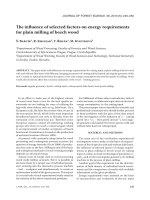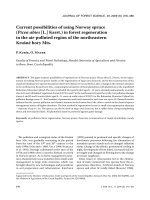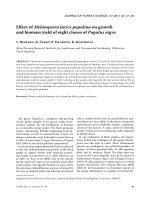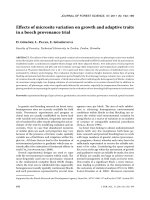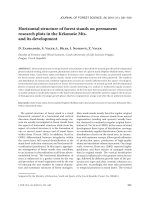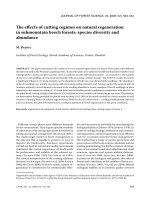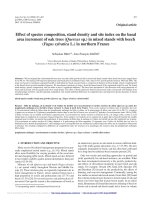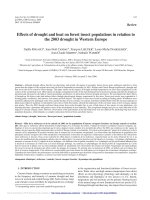Báo cáo lâm nghiệp: "Effects of microsite variation on growth and adaptive traits in a beech provenance trial." pps
Bạn đang xem bản rút gọn của tài liệu. Xem và tải ngay bản đầy đủ của tài liệu tại đây (399 KB, 8 trang )
192 J. FOR. SCI., 57, 2011 (5): 192–199
JOURNAL OF FOREST SCIENCE, 57, 2011 (5): 192–199
Eff ects of microsite variation on growth and adaptive traits
in a beech provenance trial
D. G, L. P, E. G
Faculty of Forestry, Technical University in Zvolen, Zvolen, Slovakia
ABSTRACT: The effects of the within-trial spatial variation of environmental factors on phenotypic traits were studied
in the Slovak plot of the international beech provenance trial coordinated by BFH Grosshansdorf with 32 provenances,
established under a randomized complete block design with three adjacent blocks. Five indicators of soil properties
(soil moisture, bulk density and pH) and microclimate (average daily temperature and temperature amplitude) were
assessed at 96 points distributed over a 10 × 10 m grid and their values for the positions of individual trees were
estimated by ordinary point kriging. The evaluation of phenotypic variation (height, diameter, Julian days of spring
flushing and autumn leaf discoloration, vegetation period length, late frost damage) using a common two-way analysis
of variance showed a significant provenance × block interaction effect indicating the heterogeneity of blocks. Analysis
of covariance using single-tree kriging estimates of environmental variables as covariates showed that in addition to
provenance, all phenotypic traits were significantly affected by microsite, especially by temperature fluctuation. Em-
ploying methods incorporating the spatial component in the evaluation of tree breeding field experiments is advocated.
Keywords: experimental design; Fagus sylvatica; geostatistics; microsite variation; provenance research, spatial variation
Supported by the Slovak Research and Development Agency, Grant No. APVV-0441-07 and by the COST Action E52.
In genetic and breeding research on forest trees,
homogeneous sites are scarcely available for fi eld
trials. Provenance experiments and progeny or
clonal tests are usually established on forest land
with variable soil conditions, frequently surround-
ed or bordered by older stands aff ecting the micro-
climate of the trial by modifying radiation and air
currents. Even in case that abandoned nurseries
or similar plots are used, soil properties may vary
because of the presence of former roads, spatially
variable use of fertilizers and irrigation within the
plot etc. All these factors lead to the formation of
environmental patches or gradients which may se-
riously aff ect the estimation of treatment eff ects in
trials (Y, J 2008).
Several experimental designs are used to cope
with the environmental variation within trials. e
most frequently used one in provenance research
is the randomized complete block (RCB) design,
where the trial area is subdivided into supposedly
homogeneous (usually spatially continuous) blocks
and each provenance represented by several trees
appears once per block. e aim of such subdivi-
sion is achieving homogeneous environmental
conditions within blocks so that blocking can re-
move the within-trial environmental variation by
using blocks as a source of variation in an analysis
of variance or comparable statistical procedures
(S, R 1995).
As forest trees belong to almost undomesticated
plants (with very few exceptions), both basic ge-
netic research and practical breeding have to work
with large numbers of genetic entries (provenanc-
es, progenies, clones), whereby each entry has to be
suffi ciently represented to receive the reliable esti-
mate of its value. Considering the space required
for a tree at the age when the assessment of growth
and qualitative traits can reliably be made, the sizes
of blocks are usually too large to achieve environ-
mental homogeneity in fi eld trials on forest trees.
is results in a signifi cant block × entry interac-
tion, leading to problems in the interpretation of
the outcomes of statistical analyses (P 2001;
S-R et al. 2001). Moreover, microsite
J. FOR. SCI., 57, 2011 (5): 192–199 193
conditions frequently exhibit spatial continuity at
scales larger than the plot size but smaller than the
block size, leading to spatial continuity of the mea-
sured traits. It has been shown by many studies on
forest trees that the observed values on neighbour-
ing plots tend to be more similar than the obser-
vations on distant plots (F et al. 1999; J et
al. 2002; D et al. 2006; Z et al. 2007;
Z 2008). In several cases, direct relationships
between the environmental spatial variation and
response patterns in genetic tests were observed,
such as soil properties and visual Mg-defi ciency
symptoms (B et al. 2004) or wind patterns and
Armillaria infection (M et al. 2002; A-
et al. 2005).
Spatial continuity poses a problem for the use of
common statistical methods which are designed for
samples drawn from random variables with inde-
pendent and identically distributed errors (S,
R 1995). Several statistical techniques were
proposed to solve this problem, which are gener-
ally based on searching for spatial structures in the
data themselves incorporating the spatial aspect
directly into the statistical treatment (L
et al. 1990; F et al. 1998; D et al. 2002;
C et al. 2005; H et al. 2005; G
et al. 2007). However, the question remains how
the variation in traits of interest can be linked with
directly measurable environmental indicators. e
aim of this study was to clarify to what extent the
spatial variation of environment aff ects growth and
adaptive traits in a provenance trial, and whether
blocking can effi ciently handle this variation.
MATERIALS AND METHODS
e study is based on the analysis of the Slovak
trial plot of the international European beech (Fa-
gus sylvatica L.) provenance experiment coordi-
nated by the Federal Research Institute for Rural
Areas, Forestry, and Fisheries,Institute for Forest
Genetics, Grosshansdorf, Germany. e trial was
established in 1998 in an abandoned forest nursery
of ~ 1 ha at the locality Tále-Jablonka (central Slo-
vakia, 19°02'E, 48°38'N, 810 m a.s.l.) with 2-years-
old seedlings of 32 provenances covering practical-
ly the whole distribution range of beech in Europe,
using the RCB design (three adjacent blocks).
In 2007 (at the age of the trial of 11 years), com-
plex measurements of the trial were performed.
Among growth traits, height and diameter (at breast
height and at the height of 0.2 m) were recorded.
As a strong night frost (up to –8°C) occurred dur-
ing the night from 30 April to 1 May, frost damage
was recorded subsequently using a 5-point scale
(0 – less than 5% of leaves damaged, 1 – less than 1/3
of leaves damaged, 2 – less than 2/3 of leaves dam-
aged, 3 – less than 95% leaves damaged, 4–more
than 95% leaves damaged). Spring fl ushing was
scored on 12 days covering the whole fl ushing sea-
son of all trees using a modifi ed scale of W-
et al. (1995) (a 7-stage scale: 1 – dormant
buds, 2 – buds swollen and elongated, 3 –buds be-
gin to burst, fi rst green is visible, 4 – folded and
hairy leaves begin to appear, 5 – individually visible
folded and hairy leaves, 6 – leaves unfolded, still
fan-shaped, pale scales present, 7 –leaves unfold-
ed, smooth and bright). Autumn discoloration was
scored on 6 dates, again dispersed over the whole
season, using a 5-stage scale (1 – green leaves,
2 – beginning of autumn colouring of individual
leaves, 3 – beginning of autumn leaf colouring on
a mass scale, 5–10% of leaves coloured, 4– mass
autumn leaf colouring, ~ 50% of leaves coloured,
5 – completed leaf colouring, 6 – leaves start to
turn brown and to dry). e process of fl ush-
ing represents an irreversible transition between
two temporarily steady states: buds are closed for
the whole winter, at a certain moment they start
to open, develop into green leaves which remain
green for the whole summer. Such a process can be
best modelled by a sigmoid function:
2
tanh21
w
cd
p
−
+
=
where:
p – the phenological stage at Julian day d
c – the midpoint of fl ushing, i.e. the Julian day when
the middle stage is achieved (in our case, stage 4),
w – the duration of the process,
tangens hyperbolicus tanh x = (e
x
– e
–x
)/(e
x
+ e
–x
).
e same approach was used for the modelling of
autumn discoloration. e length of the vegetation
period was then assessed as the diff erence between
the midpoints of autumn discoloration and spring
fl ushing.
As the measured traits exhibited an obvious spa-
tial continuity not only at the tree level but also at
the provenance level (raw data available at the cor-
responding author), we mapped the variation of se-
lected soil properties and microclimatic variables
over the trial plot at 96 points, located in the centre
of each provenance plot within each block (i.e. on
a 10 × 10 m grid). Soil samples were taken on Au-
gust 29, 2007, which was a day after a 15-day period
of summer drought, from the uppermost soil layer
194 J. FOR. SCI., 57, 2011 (5): 192–199
(0 to 10 cm) using 100 ml Kopecky sampling cyl-
inders to determine bulk density of soil. Moreover,
samples from the 10 to 20 cm depth were used to
assess the distribution of soil acidity (pH/H
2
O) and
soil moisture (gravimetrically, after drying at 105°C
for 24 h). Soil temperatures were measured at the
10-cm depth on September 3, 2007 (a day with sun-
ny weather) each hour from 07:00 to 18:00 using
96 Hg-thermometers. From temperature measure-
ments, the average temperature and the amplitude
were calculated.
Single-tree estimates of environmental variables
were obtained through kriging. Sample omnidirec-
tional variograms with 7.07 m (= ½ diagonal dis-
tance between sampling points) distance classes
were constructed based on the observed data for
all environmental variables and fi tted to appropri-
ate models. Ordinary point kriging was then used
to estimate the values of environmental variables at
the location of each tree. Variowin 2.2 (P
1996) was used for all geostatistical analyses.
Two approaches were subsequently used for the
statistical treatment of the data. Firstly, we applied
a two-way analysis of variance under the classical
RCB design. Both provenances and blocks were
considered to be random-eff ect factors. Secondly,
we used analysis of covariance with provenance
as a categorical predictor and environmental vari-
ables as continuous covariates.
RESULTS
As shown in Fig. 1, the distributions of all en-
vironmental variables are spatially continuous. In
the case of temperature regime descriptors and
soil moisture, this is obviously due to the eff ect of
shading. e trial plot is immediately surrounded
by an adult beech stand (~ 110 years, mean stand
height 31 m). e southern side of the plot receives
direct sunlight in the morning, from the noon on-
wards it is completely shaded. e highest daily
temperatures were observed along the SW-NE di-
agonal, which is the line receiving the highest solar
radiation. Daily amplitude of temperatures follows
a very similar (although not identical) pattern. e
largest temperature fl uctuations were observed in
the centre of the plot, whereas they decrease to-
wards the margins, infl uenced microclimatically
by the adjacent beech stands. Consequently, soil
moisture is high along the southern side of the tri-
al plot, whereas in the centre the soil suff ers from
water defi cit. A close coincidence of temperature
and soil moisture patterns indicates that evapora-
tion driven by solar irradiation is a more important
determinant of soil water content than water reten-
tion capacity resulting from the soil texture and
structure on this trial plot. e temperature and
moisture pattern is refl ected in the ground-layer
vegetation at places where the canopy has not been
closed yet: the large patch with a high soil moisture
and a cold microclimate parallel to the southern
side is covered by Tussilago farfara L. and Salix ca-
prea L., whereas the open patches in the centre are
overgrown with clonally spreading grasses, mainly
Calamagrostis arundinacea (L.) Roth.
As the area had been used as a forest nursery
before being converted into a provenance trial, we
suspected that there might have been a road along
the axis of the plot with compacted soil. However,
the assessment of bulk density of soil did not con-
fi rm this assumption. ere are patches of high and
low soil density, maybe resulting from the former
use, but they are irregularly distributed over the
trial plot.
Soil acidity follows a relatively smooth gradient
from the NW to the SE corner of the plot. Local
fl uctuations may be associated with the former use,
but the plot-wide trend itself seems to be caused
by changes in the bedrock, as the trial is located in
a volcanic area where lava streams and tuff sedi-
ments of varying chemical composition may alter-
nate over small distances.
Experimental variograms refl ect the observed
spatial continuity in environmental data, as the
semivariance increases with distance in all vari-
ables, at least for distance classes up to 40 m (= one
half of the shorter dimension of the rectangular tri-
al plot). Out of the fi ve variograms, 2 were fi tted to
the classical spherical model, 2 to the exponential
model and 1 to the Gaussian model (Fig. 2).
e analysis of data under the classical RCB design
brought expected outcomes (Table 1). e eff ect of
provenance proved to be signifi cant for all assessed
traits, which is not surprising considering that the
set of tested provenances covers almost the whole
distribution range, even comprising one population
belonging to a diff erent taxon (Gramatikovo, Bul-
garia, F. sylvatica L. ssp. orientalis Lipsky). e eff ect
of blocks was non-signifi cant with a single exception
of the fl ushing midpoint date, proving that the spa-
tial arrangement of blocks used was very ineffi cient
in handling the microenvironmental variation with-
in the trial site. All blocks are clearly heterogeneous
with respect to all environmental variables that we
assessed. On the other hand, the provenance × block
interaction was highly signifi cant (P < 0.001) for all
traits, indicating that there exists environmental
J. FOR. SCI., 57, 2011 (5): 192–199 195
variation aff ecting the phenotypic expression on
a scale larger than a provenance plot size within a
block but smaller than the block size. e percent-
ages of variance explained by the models range from
29% to 46%, indicating that a substantial portion
of the trait variation is caused by genetic variation
within populations and/or environmental variation
on very small scales.
Analysis of covariance confi rmed the expected
signifi cant provenance eff ect on all traits (Table2).
Generally, growth traits were signifi cantly infl uenced
by soil properties. Among microclimatic indicators,
temperature fl uctuation during the day rather than
the daily average seems to infl uence yield and adap-
tive traits. A signifi cant eff ect of soil pH on phenol-
ogy traits might be a statistical artifact resulting
from the spatial pattern: soil acidity changes along
the NE-SW gradient, which partially coincides with
the spatial pattern of the amount of solar radiation.
On the other hand, a direct relationship (although
Soil moisture Soil bulk density
Soil pH Average temperature
Temperature amplitude
min
1
st
quartile
2
nd
quartile
3
rd
quartile
4
th
quartile
max
0 20 40 60 80 100 1200 20 40 60 80 100 120
0 20 40 60 80 100 120 0 20 40 60 80 100 120
0 20 40 60 80 100 120
80
60
40
20
0
80
60
40
20
0
80
60
40
20
0
80
60
40
20
0
80
60
40
20
0
x (m)
x (m)
x (m) x (m)
x (m)
y (m)
y (m)
y (m)y (m)y (m)
Fig. 1. Spatial patterns of the assessed envi-
ronmental variables over the area of the beech
provenance trial
Table 1. Analysis of variance (signifi cance of F-tests) of the beech provenance trial under the RCB design: full set of
provenances
Trait
Source of variation
R
2
provenance block provenance × block
Height *** NS *** 0.330
Diameter at 1.3 m *** NS *** 0.314
Diameter at 0.2 m *** NS *** 0.288
Flushing midpoint *** ** *** 0.457
Cessation midpoint *** NS *** 0.370
Vegetation period *** NS *** 0.393
Frost damage *** NS *** 0.406
*P > 0.95, **P > 0.99, ***P > 0.999, NS – not signifi cant
196 J. FOR. SCI., 57, 2011 (5): 192–199
not necessarily causal) between phenology and soil
reaction has been found in beech (B 1991).
DISCUSSION
Actually, direct inclusion of environmental vari-
ables did not increase the predictive power of the
models: R
2
for ANCOVA models were lower com-
pared to ANOVA under the RCB design for all
traits. is was not surprising considering the fact
that the phenotypic response to environmental fac-
tors need not necessarily be linear (R et
al. 1999). Moreover, quite rough indicators of mi-
croclimate and very incomplete descriptors of soil
properties were used. Temperature measurements
performed during one day only do not properly
characterize the temperature regime of the trial
plot. On the other hand, as they were taken on a
sunny summer day when the largest temperature
diff erences between irradiated and shaded places
can be expected, on a large number of measur-
Fig. 2. Experimental variograms
and variogram models for the as-
sessed environmental variables.
Dashed line – overall variance
Soil moisture Soil bulk density
Soil pH
Average temperature
Temperature amplitude
40
30
20
10
0
0.056
0.042
0.028
0.014
0
0.014
0.012
0.010
0.008
0.006
0.004
0.002
0
1.6
1.2
0.8
0.4
0
5.6
4.2
2.8
1.4
0
0 6 12 18 24 30 35 42 48
(h)
0 6 12 18 24 30 35 42 48
0 6 12 18 24 30 35 42 48
0 6 12 18 24 30 35 42 48
0 6 12 18 24 30 35 42 48
y (h)
(h)
(h)
(h)
(h)
y (h)
y (h)
y (h)
y (h)
Table 2. Analysis of covariance (signifi cance of F-tests) of the beech provenance trial considering soil properties and
temperature distribution as covariates
Trait
Source of variation
R
2
provenance
soil temperature
moisture density pH/H
2
O average amplitude
Height *** NS ** * NS *** 0.248
Diameter at 1.3 m *** *** ** *** NS *** 0.220
Diameter at 0.2 m *** ** ** *** NS *** 0.225
Flushing midpoint *** NS NS *** NS NS 0.408
Cessation midpoint *** NS NS * ** *** 0.249
Vegetation period *** NS NS * NS *** 0.286
Frost damage *** *** NS NS NS *** 0.317
*P > 0.95, **P > 0.99, ***P > 0.999, NS – not signifi cant
J. FOR. SCI., 57, 2011 (5): 192–199 197
ing points, they should properly refl ect the spa-
tial distribution of heat accumulation within the
plot. We preferred to measure soil temperatures
as they exhibit less random fl uctuations than air
temperatures, mainly when the tree distribution
over the plot is fairly irregular, and are important
for the phenology of hardwoods (B et al.
2005; D, E 2006). e same applies
to soil properties. Soil moisture is known to aff ect
growth and even phenology in beech (N,
J 2003; S 2006; J et al.
2007). However, the permanent monitoring of soil
water content over a large network of points regu-
larly distributed over the trial plot was not feasible
technically. Nevertheless, scoring soil moisture af-
ter a relatively long drought (15 days) allowed us
to distinguish the places with a regular rapid de-
crease of moisture due to exposure to radiation
from places retaining soil water even in the upper
densely rooted layers. Similarly, bulk density and
acidity are only two examples of physicochemical
soil variables, and although they were shown to af-
fect growth in beech (R 1985), by far they do
not exhaust all soil properties that may be relevant.
However, we have to remind that constructing a
predictive model of beech growth or phenology
based on environmental variables was not our ob-
jective, and it would hardly be possible on the basis
of a single provenance trial. Even such rough envi-
ronmental indicators as we used succeeded to fi lter
out a part of environmental variability.
e question remains whether a diff erent ar-
rangement of blocks could effi ciently treat the mi-
crosite variation within the trial. As the tempera-
ture amplitude exerted a highly signifi cant eff ect on
both growth and phenology traits, we used it for a
redefi nition of replications within the trial. Prov-
enance plots were ranked according to the tem-
perature amplitude and classifi ed into three equal-
size classes (blocks): with high, average and low
temperature fl uctuation, without respect to spatial
continuity (Table 3). Provenances were represented
in the newly defi ned classes very irregularly: ex-
treme cases are two provenances placed solely in
high-fl uctuation patches within all their original
blocks. Such patches represent the least suitable
environment, resulting in high mortality (data not
shown). Actually, a kind of positive feedback may
have contributed to this pattern: the plots of mal-
adapted provenances with poor growth and high
mortality remain open, without closed canopy, and
thus exposed to microclimatic extremes, leading to
a further drop of survival (S-R et al.
2001). e subset of provenances represented in all
three “blocks” contained only 10 out of the 32 prov-
enances, and was subsequently subjected to a re-
peated analysis of variance under the RCB design.
As expected, this approach did not help very much.
For some traits, R
2
slightly improved, but the prov-
enance × block interaction remained signifi cant in
all cases. Actually, the “blocking” we used removed
only the eff ects of a single environmental factor
(temperature fl uctuation). e other ones exhibit-
ed diff erent spatial distributions. Moreover, diff er-
ent traits were shown to be diff erently infl uenced
by individual environmental variables. Naturally,
multivariate approaches such as principal com-
ponents or factor analysis can be used to extract
main environmental factors, but such factors typi-
cally represent only a minor part of environmen-
tal variation and their interpretation is not always
straightforward (G, G 1995).
Apparently, the randomized complete block de-
sign, although traditionally used in most prove-
Table 3. Analysis of variance (signifi cance of F-tests) of the beech provenance trial under the RCB design: redefi ned
blocks, subset of 10 provenances
Trait
Source of variation
R
2
provenance block provenance × block
Height * NS *** 0.332
Diameter at 1.3 m * NS *** 0.283
Diameter at 0.2 m NS NS *** 0.352
Flushing midpoint *** * *** 0.438
Cessation midpoint * NS *** 0.465
Vegetation period * * *** 0.340
Frost damage *** NS *** 0.434
*P > 0.95, **P > 0.99, ***P > 0.999, NS – not signifi cant
198 J. FOR. SCI., 57, 2011 (5): 192–199
nance experiments (Z, T 1984; K
2005), does not properly handle the spatial varia-
tion of site conditions. In our case, blocks were
delineated with respect to the shape of the trial.
However, any other systematical or random ar-
rangement of blocks would result in a similar het-
erogeneity. Naturally, if the relevant environmental
factors were thoroughly mapped on the plot prior
to establishing the experiment, the arrangement
of replications could be optimized. However, such
an approach could result in spatially discontinuous
blocks, potentially leading to problems with the
measurement of experiments. Moreover, a direct
within-trial mapping of environmental indicators
is scarcely done in breeding experiments, as the
matter of interest is mostly the composite eff ect of
environmental diff erences among trials on pheno-
typic variation rather than its decomposing into the
eff ects of single environmental factors. In any case,
the study demonstrates that the within-trial spatial
variation cannot be ignored, spatial patterns must
be considered when breeding values of parents
are assessed in progeny tests or when geographic
trends observed in provenance experiments are
interpreted in terms of adaptation. Recording tree
positions during the measurements of trials is thus
indispensable, as it allows for alternative approach-
es to evaluations (F et al. 1999; S-R et
al. 2001; C et al. 2005; D et al. 2006;
Z et al. 2007).
R efe ren ce s
A N.H., K E., M B., M E.,
W G. (2005): Analyzing the spread of beech
canker. Forest Science, 51: 438–448.
B D.D., B T.A., C P.S., F E.,
F J.D., G A., G L., K A., P
K., S H.P., V R., W K., W S., X
L., Y S. (2005): Predicting the onset of net carbon
uptake by deciduous forests with soil temperature and
climate data: a synthesis of FLUXNET data. International
Journal of Biometeorology, 49: 377–387.
B F. (1991): Phenology and components of beech leaves
in relation to the acidity of soils. Göttingen, Berichte des
Forschungszentrums Waldökosystem, Reihe B: 25.
B P.N., O G.R., K M.O., P S.H.,
R B. (2004): Genetic and soil factors associated
with variation in visual magnesium defi ciency symptoms
in Pinus radiata. Forest Ecology and Management, 189:
263–279.
C J.R., B J.S.D., R M.A.P. (2005): Neigh-
borhood and spatial analysis in plant breeding. Pesquisa
Agropecuaria Brasileira, 40: 1073–1079.
D C., E W. (2006): Phenological phases of
common beech (Fagus sylvatica L.) and their dependence
on region and altitude in Southern Germany. European
Journal of Forest Research, 125: 181–188.
D G.W., C S J., G A.R., L
G.A. (2002): Spatial analysis methods for forest genetic tri-
als. Canadian Journal of Forest Research, 32: 2201–2214.
D G.W., C S J., G A.R.,
W H., A A. (2006): Spatial analysis en-
hances modelling of a wide variety of traits in forest genetic
trials. Canadian Journal of Forest Research, 36: 1851–1870.
F Y.B., P G., C Y., N G., Y
A.D. (1998): Incomplete block designs for genetic testing:
statistical effi ciencies of estimating family means. Canadian
Journal of Forest Research, 28: 977–986.
F Y.B., Y A.D., N G. (1999): Spatial pat-
terns of tree height variations in a series of Douglas-fi r
progeny trials: implications for genetic testing. Canadian
Journal of Forest Research, 29: 714–723.
G E., G D. (1995): Relationships between
environmental factors and height growth and yield of
Norway spruce stands: a factor-analytic approach. Forestry,
68: 145–152.
G E., A A.S., M A. (2007): Mixed
spatial models for data analysis of yield on large grapevine
selection fi eld trials. eoretical and Applied Genetics,
115: 653–663.
H N., W J.G., G M.L., W R. (2005):
Spatial analysis of precision agriculture treatments in ran-
domized complete blocks: guidelines for covariance model
selection. Agronomy Journal, 97: 1082–1096.
J A., S K., I M., M H.,
P S. (2007): Ranking of European beech provenances
in Croatia using statistical analysis and analytical hierarchy.
Forestry, 80: 151–162.
J D., F R., F Y.B. (2002): Spatial patterns of tree
height variations in a black spruce farm-fi eld progeny test
and neighbors-adjusted estimations of genetic parameters.
Silvae Genetica, 51: 13–18.
K A. (2005): Provenance research: evaluation the spa-
tial pattern of genetic variation. In: G T., T
J. (eds): Conservation and Management of Forest Genetic
Resources in Europe. Zvolen, Arbora Publishers and Rome,
IPGRI: 275–334.
M B., M E., K E., W
G. (2002): Spatial dispersal of Nectria ditissima canker of
beech in an international provenance trial. Forest Pathol-
ogy, 32: 137–144.
L P., O N.L., S R.R., V A., K J.Y.
(1990): Approximate analysis of variance of spatially auto-
correlated regional data. Journal of Classifi cation, 7: 53–75.
N C.N., J F.V. (2003): Phenology and di-
ameter increment in seedlings of European beech (Fagus
sylvatica L.) as aff ected by diff erent soil water contents:
J. FOR. SCI., 57, 2011 (5): 192–199 199
variation between and within provenances. Forest Ecology
and Management, 174: 233–249.
P Y. (1996): VARIOWIN: Software for Spatial Data
Analysis in 2D. New York, Springer-Verlag: 91.
P C. (2001): ANOVA: Experimental layout and
analysis. In: S S.M., G J. (eds): Design
and Analysis of Ecological Experiments. Oxford, Oxford
University Press: 63–76.
R G.E., Y C.C., S D.L., H
D.A. (1999): Genetic responses to climate in Pinus con-
corta: niche breadth, climate change, and reforestation.
Ecological Monographs, 69: 375–407.
R P. (1985): Untersuchung über das Wachstum der Bu-
che in Baden-Württemberg. Stuttgart, Schriftenreihe der
Landesforstverwaltung Baden-Württemberg: 61.
S-R C., N E.V., G R.R., C
P.M. (2001): A case study of a provenance/progeny test
using trend analysis with correlated errors and SAS PROC
MIXED. Silvae Genetica, 50: 127–135.
S B. (2006): Spring phenology of European beech
(Fagus sylvatica L.) in submountain beech forest stand with
various stocking between 1995–2004. Journal of Forest
Science, 52: 208–216.
S R.R., R F.J. (1995): Biometry: e Principles and
Practice of Statistics in Biological Research. New York,
W.H. Freeman and Co.: 887.
W G., K D., M H.J. (1995): Varia-
tion in temperature sum requirement for fl ushing of beech
provenances. Silvae Genetica, 44: 343–346.
Y T.Z., J K.J.S. (2008): Effi ciency of using
spatial analysis in first-generation coastal Douglas-fir
progeny tests in the US Pacifi c Northwest. Tree Genetics
and Genomes, 4: 677–692.
Z R. (2008): e impact of spatial heterogeneity on selec-
tion: a case study on Pinus pinaster breeding seedling or-
chards. Canadian Journal of Forest Research, 38: 114–124.
Z R., S A., S L. (2007): Variography and
kriging allow screening Pinus pinaster resistant to Armil-
laria ostoyae in fi eld conditions. Forestry, 80: 201–209.
Z B., T J. (1984): Applied Forest Tree Improve-
ment. New York, Wiley: 505.
Received for publication July 2, 2010
Accepted after corrections January 5, 2011
Corresponding author:
Dr. D G, Technical University in Zvolen, Faculty of Forestry, T.G Masaryka 24,
960 53 Zvolen, Slovakia
e-mail:
